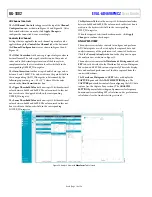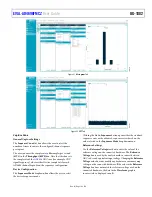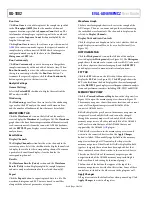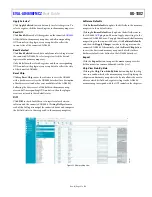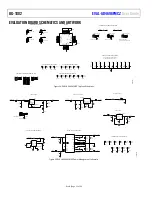
UG-1882
Rev. 0 | Page 7 of 28
REFERENCE
The EVAL-AD4696FMCZ includes an on-board precision
voltage reference and a reference buffer that supplies the REF pin
on the
. The 5 V reference is provided by the
(U3), which is an ultralow noise, high accuracy reference
source. The
(A10) functions as a reference buffer.
C1 functions as the REF decoupling capacitor (see Figure 24).
The EVAL-AD4696FMCZ provides several options for driving the
AD4696 REF input. Jumper JP11 (see Figure 28 and Table 5) selects
between the on-board voltage reference (U3, see Figure 25) and
an external, user supplied reference source (via the P5 terminal
block, see Figure 28).
The selected reference source (on board or external) is also used
to generate a dedicated V
REF
/2 voltage and drive the dc bias
amplifiers, U7 and U9. The dedicated V
REF
/2 voltage is reserved
for setting the COM pin for the COM referenced pseudobipolar
mode. See the Configuring DC Channels (IN2 Through IN15)
section and the Hardware Configurations for Supporting
AD4696 Polarity Modes section for a description of how these
voltages are used in evaluating AD4696 performance.
The AD4696 reference input high-Z mode feature effectively lowers
the current consumption of the REF pin when performing
conversions (see the AD4696 data sheet for more information).
The reference input high-Z mode is enabled by default, but can
be disabled via the REFHIZ_EN bit (see the Memory Map View
section).
Table 5. JP11 Positions for Selecting Reference Source
Position
Reference Source
A
External reference via P5
B (Default)
On-board reference via U3
POWER SUPPLIES
The EVAL-AD4696FMCZ is designed to operate from a 12 V
supply (labeled VPWR_12V) and a 3.3 V supply (labeled
VCC_HOST) provided from the host controller board via the
FMC connector (P1). Alternatively, VPWR_12V can be
provided from an external source via the VPWR test point. If
the controller board in use does not provide the 12 V supply,
the user can provide it through VPWR test point. The on-board
power circuitry converts the 12 V VPWR_12V supply into
voltage rails to power the AD4696, the A0 to A8 amplifiers, the
5 V on-board reference, and other support circuitry.
The
(U2) converts VPWR_12V (12 V) to approximately
7.5 V.
(U4) converts VCC_HOST (3.3 V) to −V_SUP
(−3.3 V). Using 7.5 V and −3.3 V (V_SUP),
(U5)
gen5 V and −2.5 V.
(U6) generates a 1.8 V rail
from the 5 V rail.
Setting Amplifier Supply Voltages
The positive and negative voltage supply rails of the on-board
amplifiers (A0 to A8, A10, U7, and U9) can optionally be set to
+7.5 V or +5 V, and −2.5 V or ground, respectively. The on-board
amplifiers are connected to one of a set of three positive and
three negative supply banks, and the voltage of the banks can be
selected via solder links (shown in Figure 29 and Table 6). These
banks provide users a way of configuring the on-board amplifiers
with different power supply voltages. For example, tying the
amplifier negative supplies to ground, the user can evaluate the
performance of the AD4696 in unipolar supply systems. Table 6
shows the name and default settings of each bank, the solder
link that connects them to the voltage rails, and the amplifiers
powered by each bank.
Note that the symbols for A0 through A7 (ADC drivers) are
split throughout the schematic, such that the amplifier pins are
shown in Figure 26 and Figure 27, whereas the supply pins and
the supply bank solder links are shown in Figure 29.
Table 6. Voltage Supply Banks Amplifier Assignments
Supply Bank
Name
Default
Voltage
Solder
Link
Amplifiers
+VS Bank A
7.5 V
JP12
A0, A1, A2, A3
−VS Bank A
−2.5 V
JP13
A0, A1, A2, A3
+VS Bank B
7.5 V
JP14
A4, A5, A6, A7
−VS Bank B
−2.5 V
JP15
A4, A5, A6, A7
+VS Bank C
7.5 V
JP16
A8, A10, U7, U9
−VS Bank C
AGND
JP17
A8, A10, U7, U9
+VS Bank A and –VS Bank A are used to set the supply voltages of
the ADC driver amplifiers for Channel IN0 through Channel IN7
of the AD4696 (A0 through A3). +VS Bank B and –VS Bank B are
used to set the supply voltages of the ADC driver amplifiers for
Channel IN8 through Channel IN15 of the AD4696 (A4 through
A7). +VS Bank C and −VS Bank C are used to set the supply
voltages of the V
REF
/2 amplifier (A8), the reference buffer (A10)
and supply voltages of the dc bias amplifiers (U7 and U9). The
grouping of the power supplies into different voltage supply
banks allows the user to implement different supplies for
different sets of amplifiers, as shown in Table 6.
Power Options for the AD4696
The AD4696 requires an analog supply (AVDD), an ADC core
supply (VDD), and I/O logic supply (VIO). Refer to the AD4696
data sheet for voltage range requirements for each of these supplies.
By default, the AVDD pin is powered by the on-board dual low
dropout (LDO) linear regulator, LT3032 (U5), and the VIO pin
is powered by the on-board 1.8 V LDO regulator, LT1761 (U6).
The VDD (1.8 V) pin of the AD4696 can be powered either
with the AD4696 internal LDO regulator, or alternatively from
the on-board LT1761 (U6). The hardware can be configured for
either of these options via connections between the on-board
supply rails and LDO_IN and VDD inputs.
To power VDD with the AD4696 internal LDO regulator, the
LDO_IN pin must be powered either by an on-board or externally
generated supply, and the VDD pin must be disconnected from any
other device (for example, left floating). The EVAL-AD4696FMCZ
is configured in the factory accordingly, with the LT1761
disconnected from the VDD pin and the LDO_IN pin driven by
LT3032 (U5). In this configuration, the AD4696 internal LDO


















